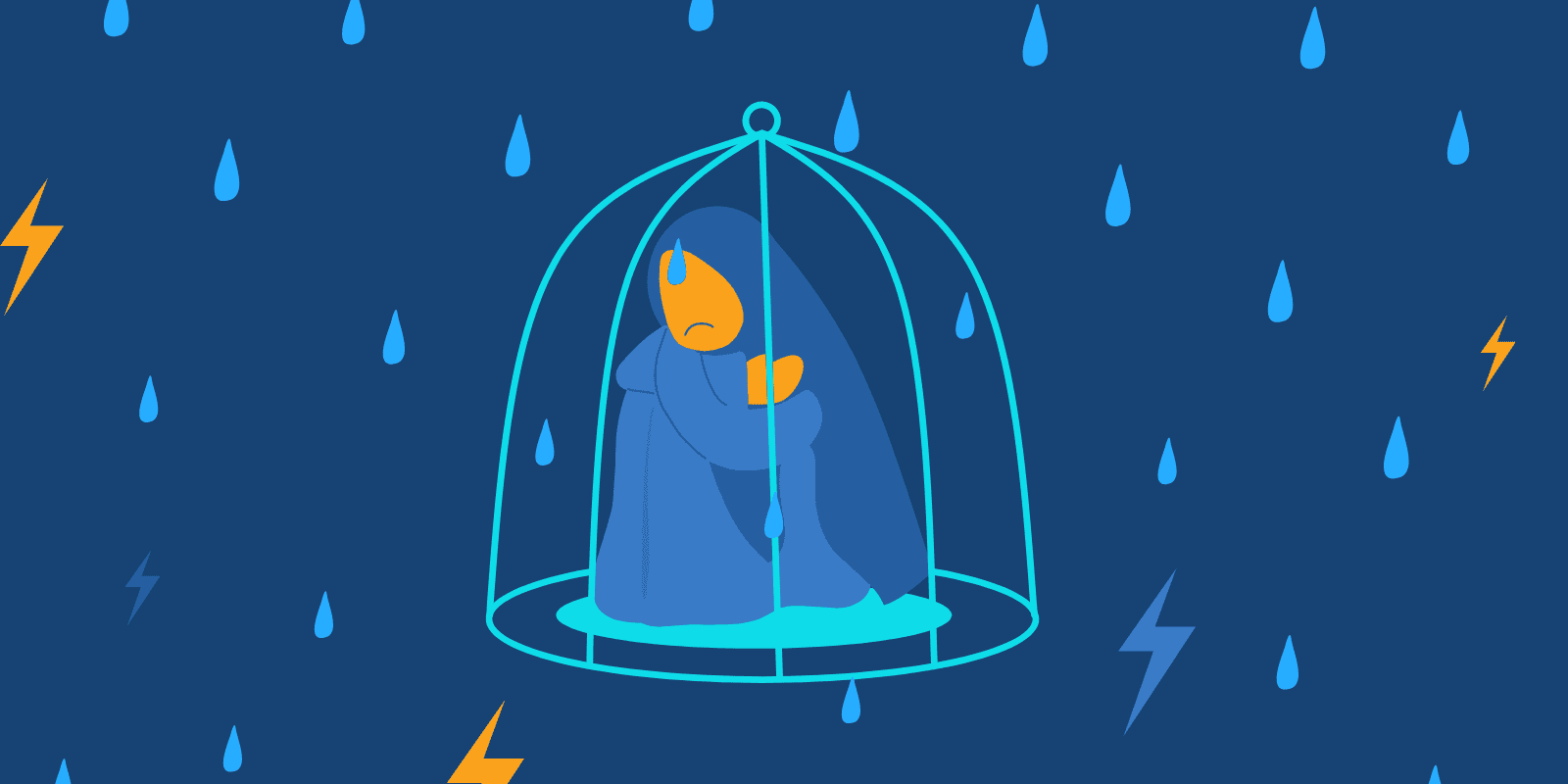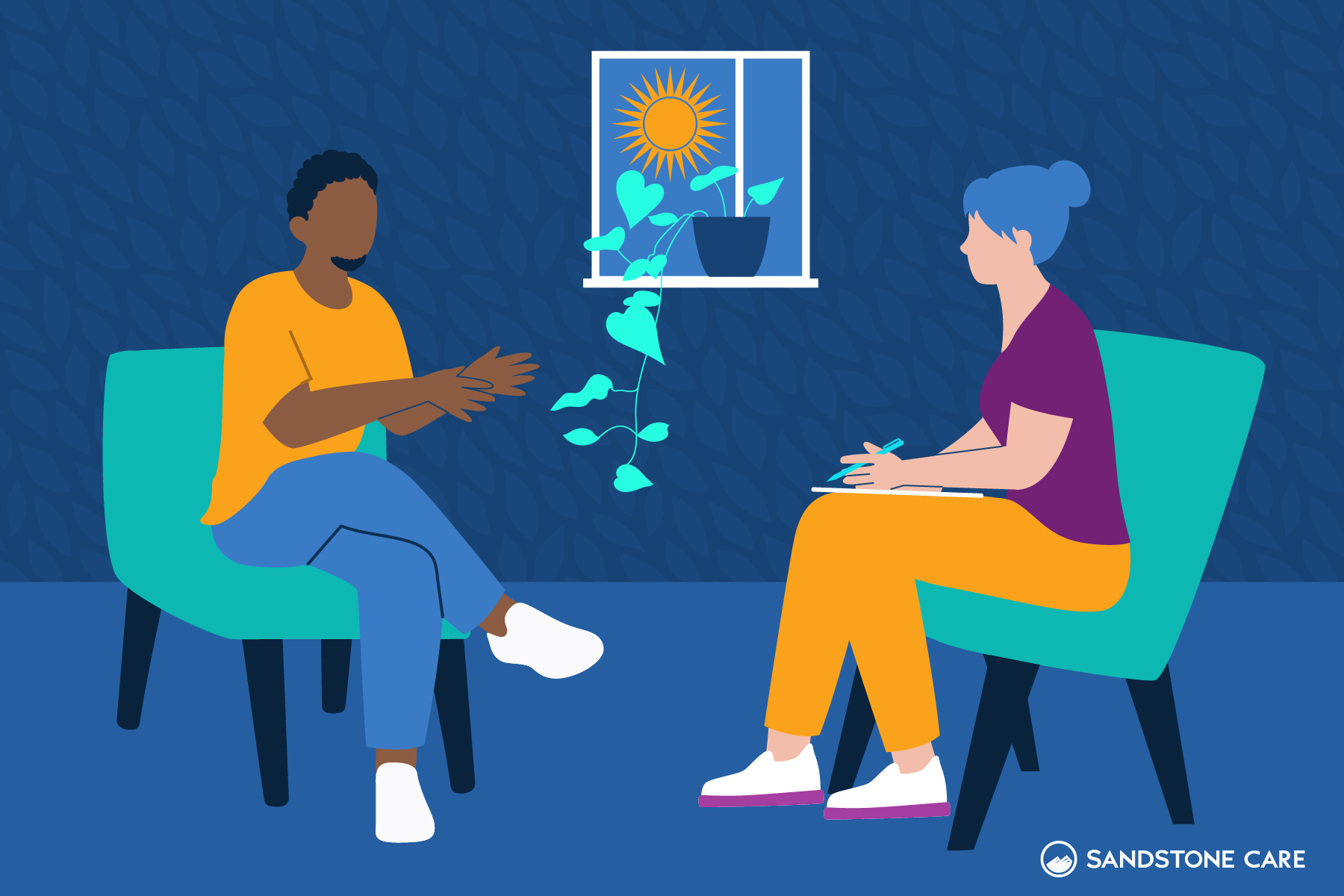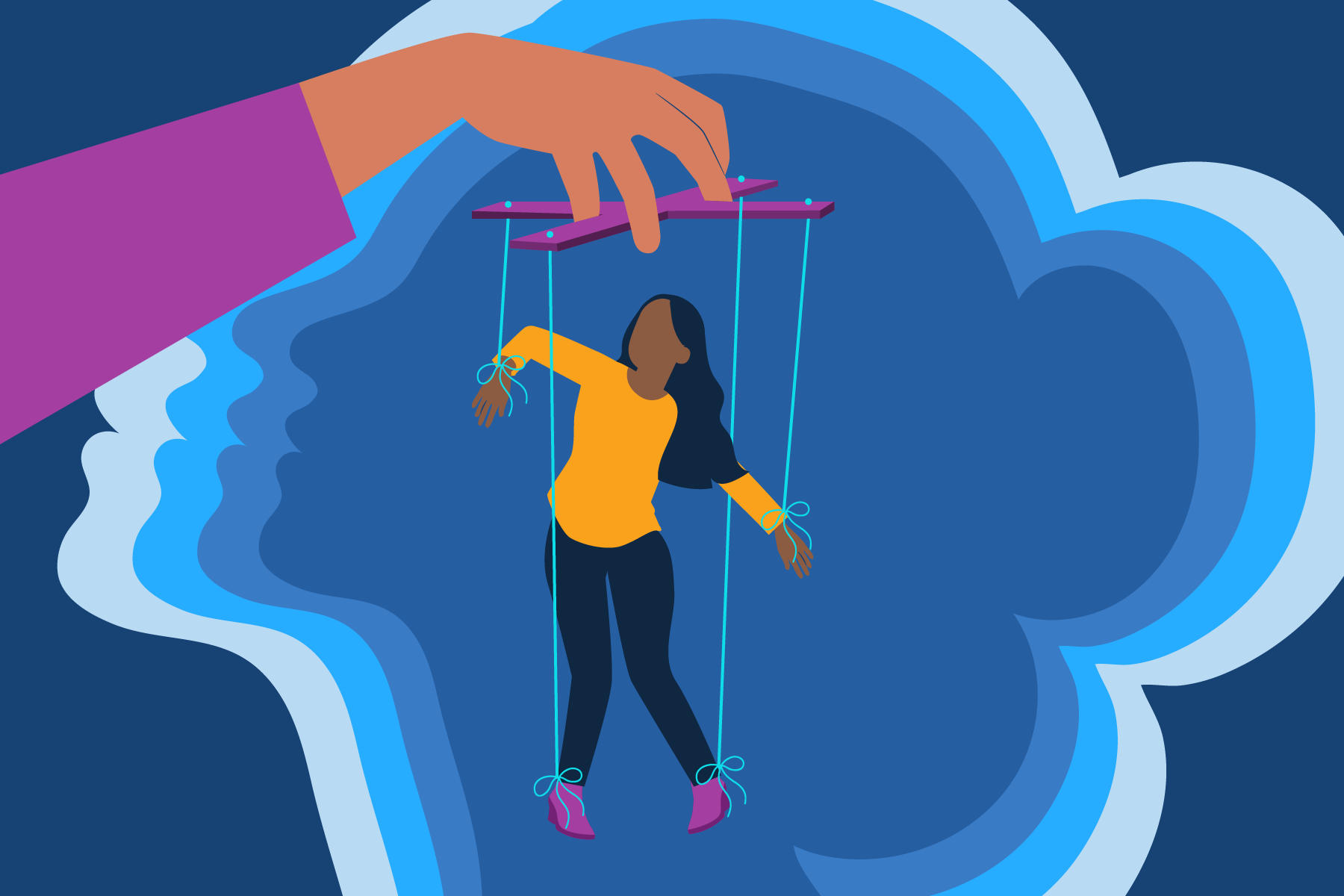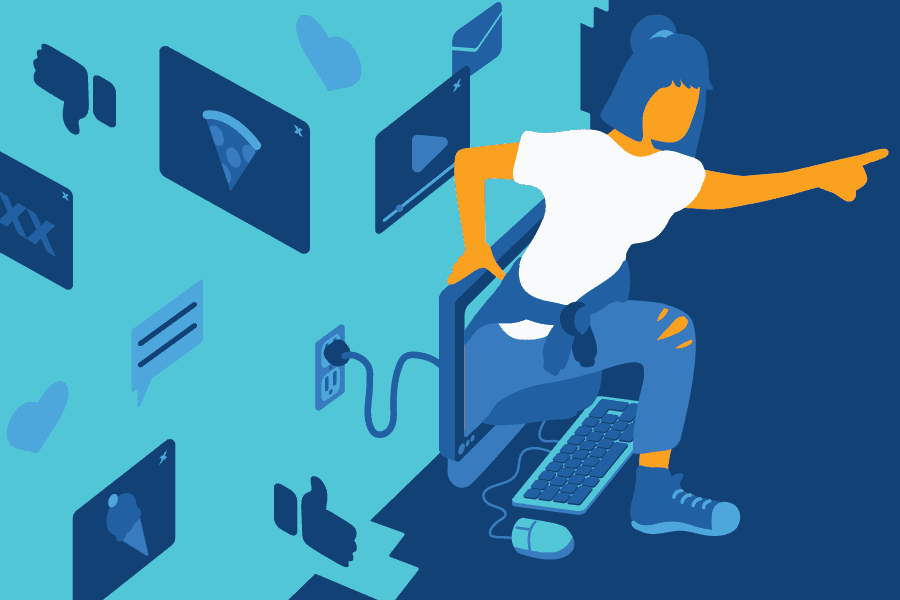Codependency Definition
What Is Codependency Or Codependent Behavior?
Codependency is a pattern of behavior or relationship where a person sacrifices and ignores their own needs and well-being for another person, whether a partner, parent, child, friend, or other family members.
Initially, the term “codependency” was used in reference to family members of individuals who struggled with substance abuse when a person would enable a person’s addiction.
Codependency hinders a person’s ability to have healthy relationships. Unlike healthy, mutual relationships, codependent relationships are one-sided and enable destructive behaviors.
Codependency is now used to reference a variety of emotional, social, and physical behaviors that aren’t only limited to those struggling with substance abuse.
Is Codependency A Learned Behavior?
Yes, codependency is a learned behavior that can be passed down to generations.
Codependency is learned by witnessing and following other family members that exhibit codependent behavior, like growing up with a codependent parent.
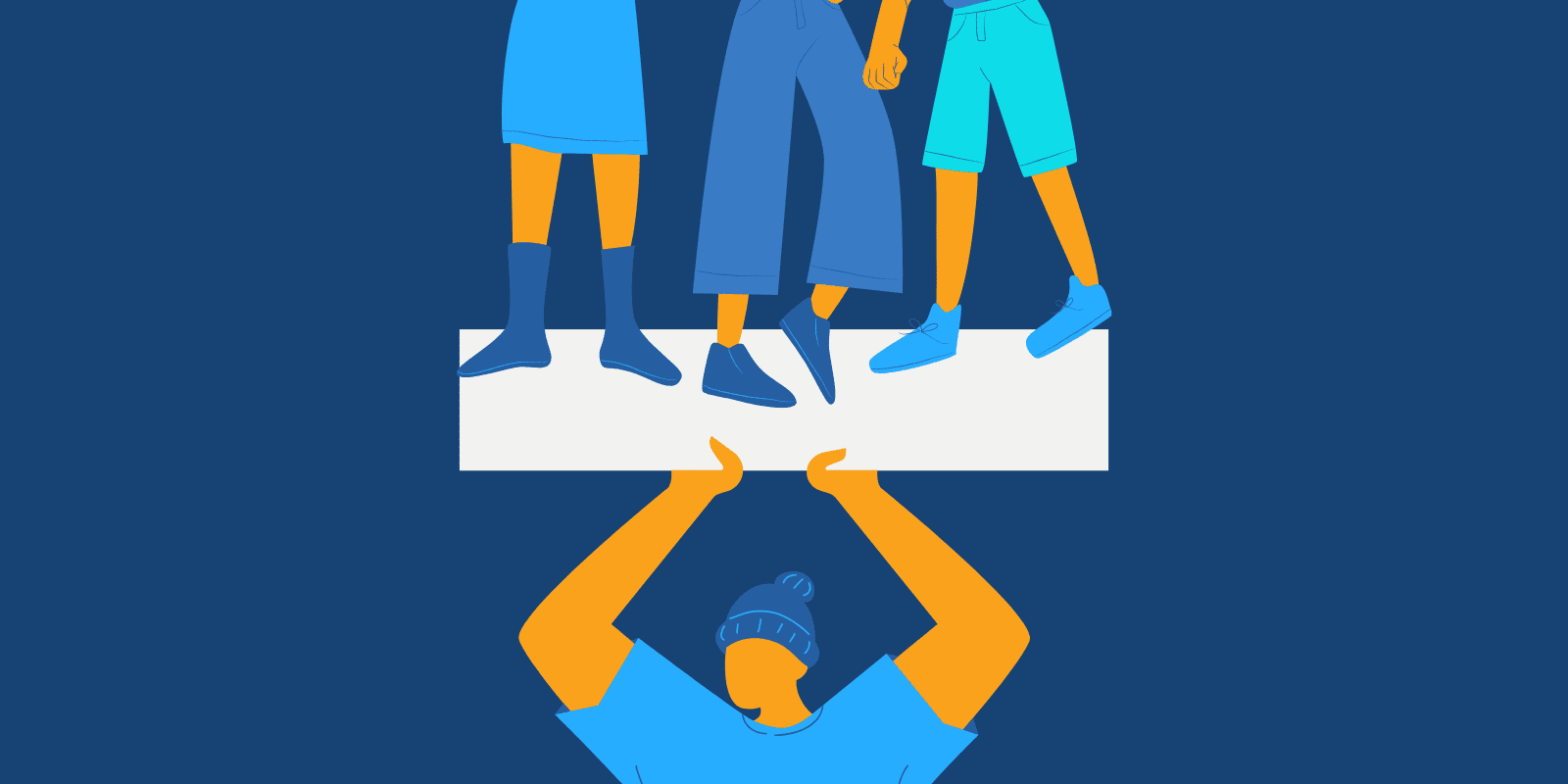
Is Codependency A Mental Illness?
The Diagnostical Statistical Manual of Mental Disorders, 5th edition, only recognizes dependent personality disorder as a mental illness, not codependency.
However, some experts argue that codependency should be considered a mental health diagnosis.
What Are Examples Of Codependency?
Codependency can look different across different relationships.
Common examples of codependency can include:
- Trying to control or “fix” someone
- Enabling destructive behaviors like substance use
- Sacrificing own physical and emotional needs or self-care for the other person
One specific example of a codependent relationship could be one where someone has a partner or a family member who is an alcoholic. They may do anything to cover up their behaviors, make excuses, or be affectionate to them even when they are being treated badly.
They think they may be able to “fix” them and blame their problems on themselves.
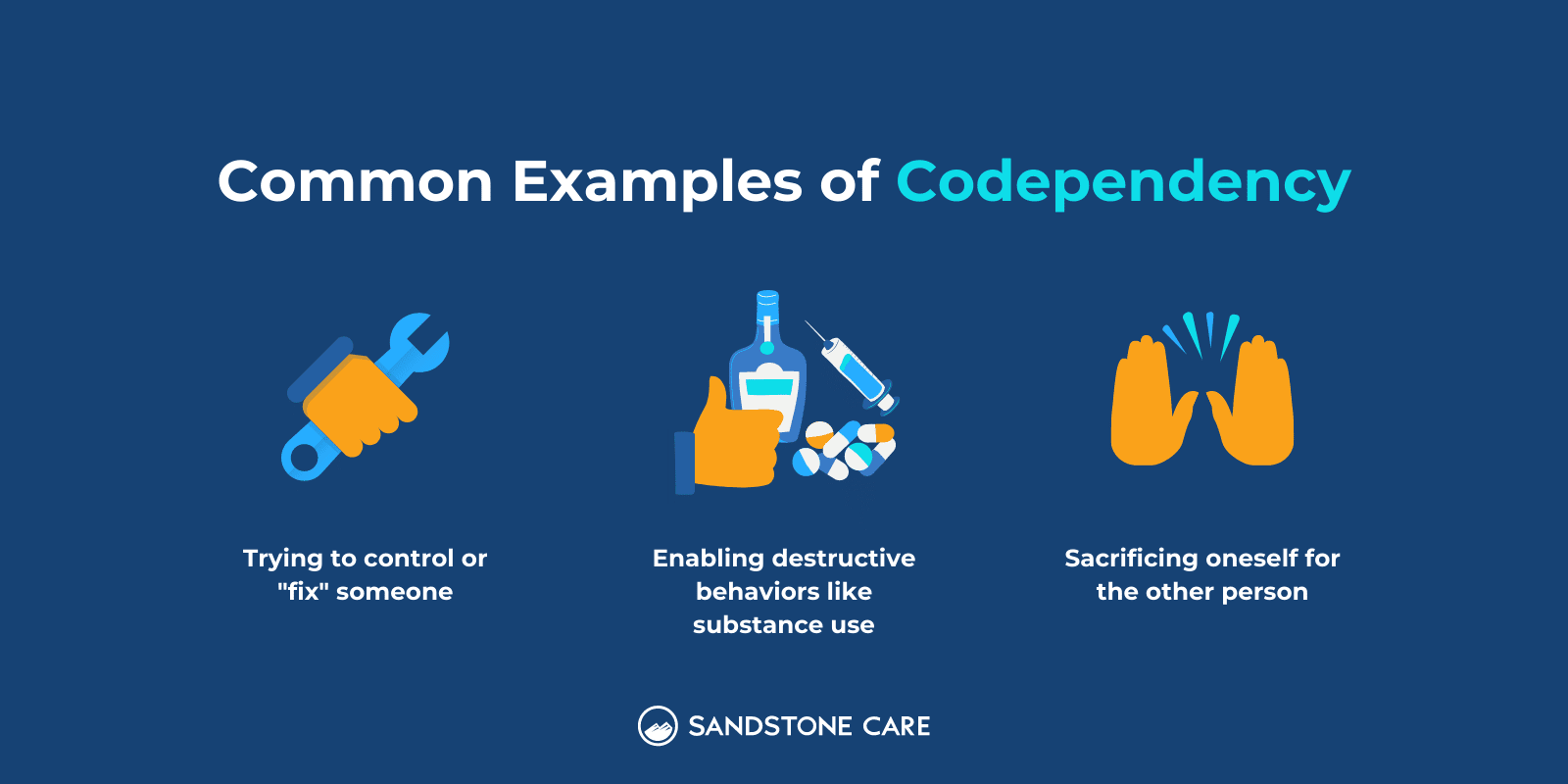
Another example of codependency can be a parent who supports their adult child.
The adult child may still live at home, not have a job or motivation to achieve any goals, and not have many responsibilities. The parent may support them financially and put their own needs aside. The parent may feel their worth from needing to be needed.
What Is Family Codependency?
Parents, siblings, and families can be codependent.
A codependent family struggles with ignored or denied feelings. Dysfunctional families do not acknowledge or confront problems. By suppressing emotions and ignoring their own needs, they develop behaviors that help them avoid difficult emotions.
When codependency is present in a family system, each family member may also struggle with a sense of identity and emotional development.
Underlying problems that may lead to family codependency can include:
- A family member struggling with addiction
- Experiences of trauma and abuse
- A family member struggling with physical or mental illness
What Are The Most Popular Misconceptions About Codependency?
Some popular misconceptions about codependency include the following:
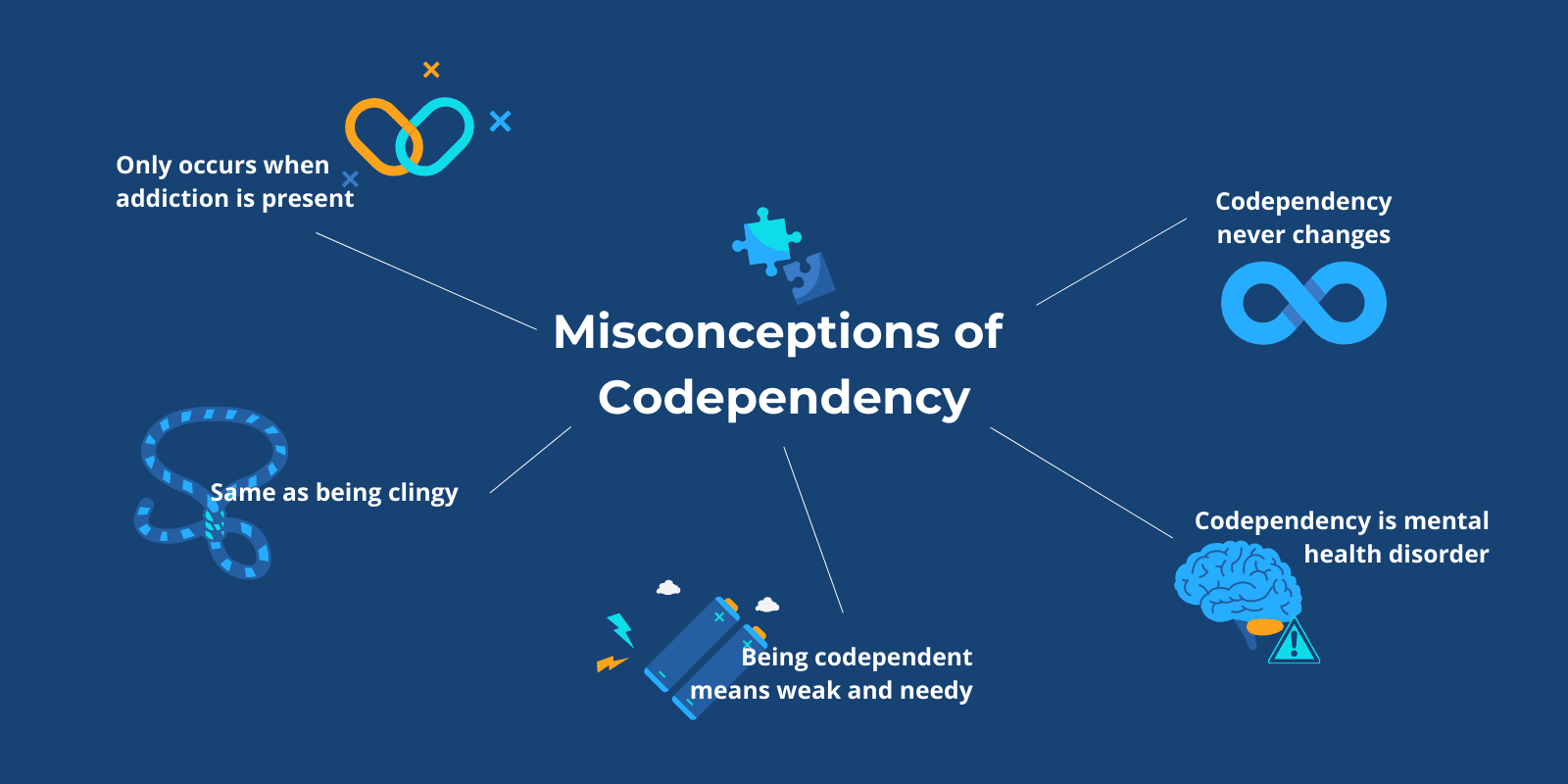
- Codependency only occurs in relationships where addiction is present
While the original term was used in reference to the loved ones of a person struggling with addiction, codependency can now refer to various situations. - Codependency is the same as being clingy in a relationship
Codependency goes way beyond clinginess in a relationship. While a codependent person may be “clingy,” it is much more than that. - People who are codependent are weak and needy
Codependent people are not weak and needy. A person who is codependent often has gone through struggles and difficulties in life and has had to be strong, yet they learned codependent behavior to cope with these difficulties. - A person who is codependent will always be codependent
A person who is codependent does not have to remain codependent forever. A person can identify unhealthy thought and behavior patterns, break habits and learn more about themselves and how to take care of themselves. - Codependency is a mental health disorder
Codependency is not recognized in the DSM-5 as a mental health disorder. Codependency refers to a pattern of behavior or relationship type and is not a mental health diagnosis. However, some experts believe it should be.
What Causes You To Be Codependent?
There is a variety of different factors that may cause a person to be codependent.
Biological, psychological, and social factors may play a role in the development of codependency.
The most common cause of codependency is negative life experiences, typically during childhood.
Other factors that may play a role in codependency in families or other relationships can include:
- History of addiction
- Experience of trauma and abuse
- History of mental or physical illness
What Is The Root Cause Of Codependency?
The root cause of codependency is often childhood trauma or adverse childhood experiences.
Even in adult relationships, the root cause of codependency usually traces back to a person’s childhood.
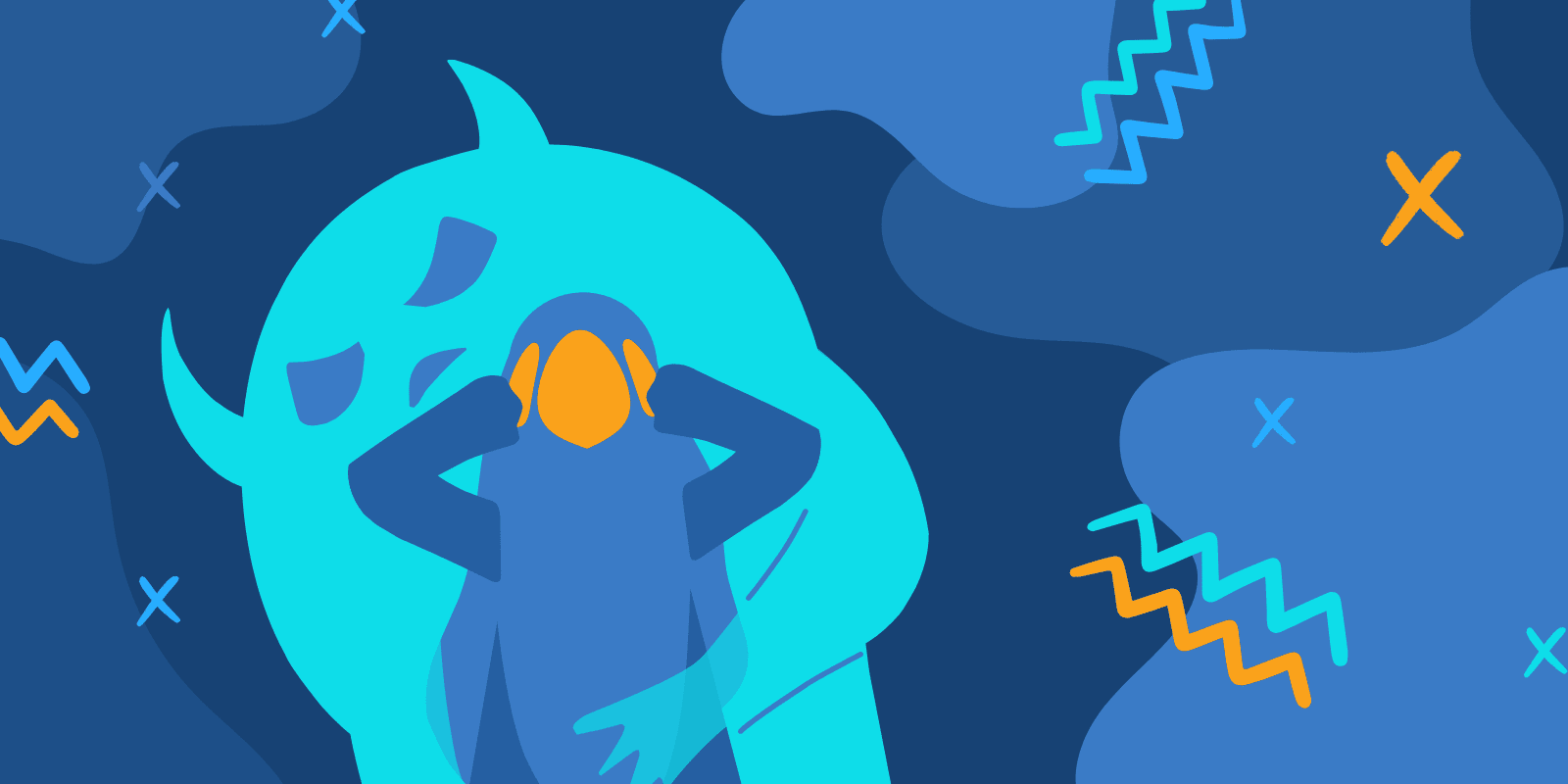
What Trauma Causes Codependency?
Codependency often stems from childhood experiences, including trauma.
SAMHSA describes trauma as a circumstance or event that results in physical, emotional, or life-threatening harm and has lasting effects on a person’s health and well-being.
Trauma can involve abuse, neglect, domestic violence, or can even be from divorce or witnessing fighting. Abuse can be emotional, sexual, or physical.
What Causes Codependency As An Adult?
Codependency as an adult usually comes from codependency as a child.
Adults often don’t realize how impactful their experiences were as a child or that there is a dysfunction in their behaviors because that is what they saw growing up, and that’s all they know.
When a person is codependent as an adult, they usually learned this behavior as a child and it stuck through to adulthood.
How Do Codependent Relationships Start?
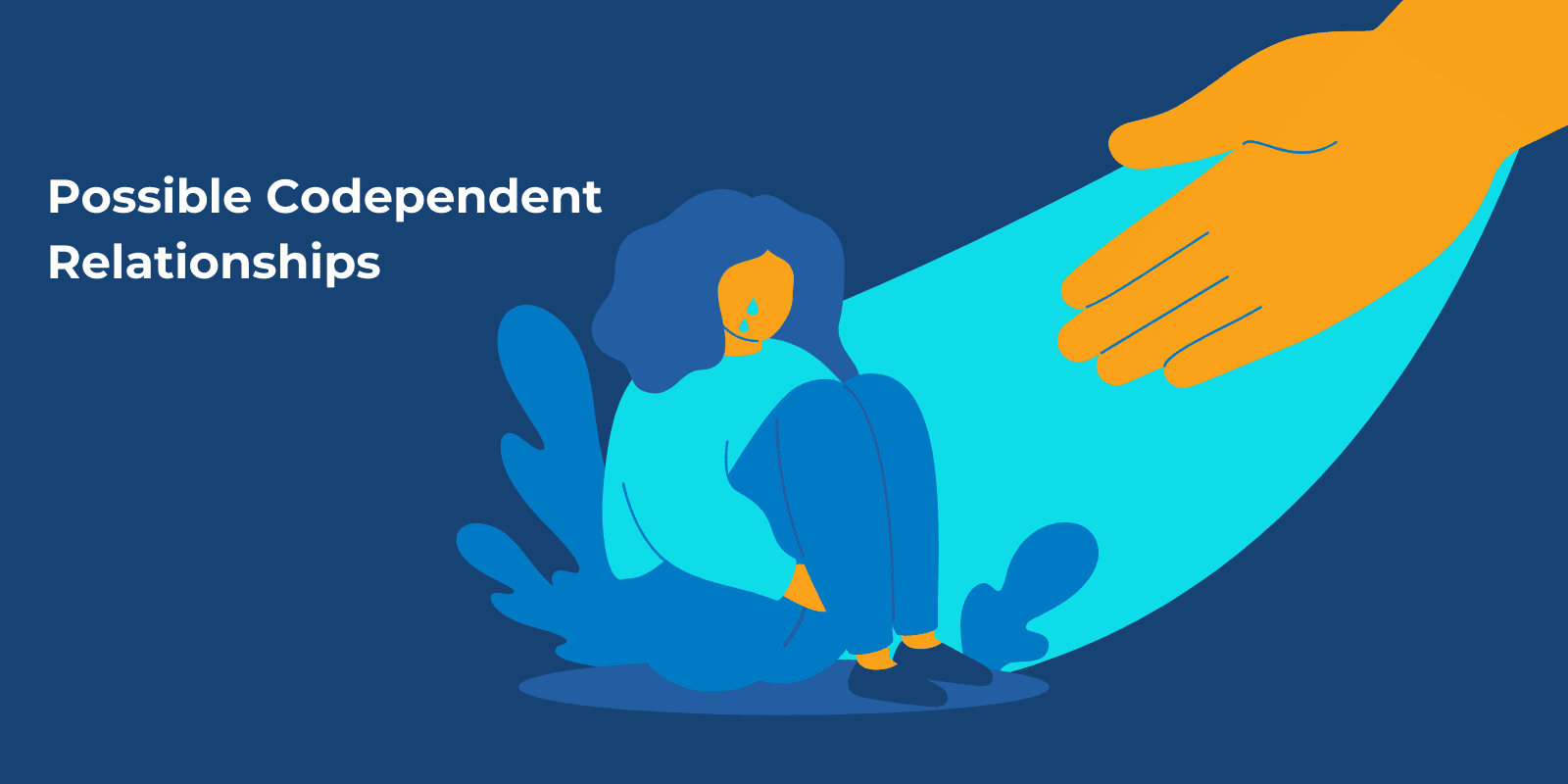
Codependent relationships can be between friends, family members, or romantic relationships.
Codependent relationships usually develop when a person has underlying problems that have been unacknowledged, unaddressed, or denied.
A codependent relationship may come from parental relationship problems. As a child, the person may have been taught that their needs don’t matter, and those beliefs may carry over into other relationships in their lives.
Codependent relationships may also develop from caring for a person who is mentally or physically ill. A person may begin to center their self-worth around being needed.
A codependent person may have good intentions. They just want to care for a person but at the cost of their health.
Lastly, experiencing physical, mental, or sexual abuse can cause many problems, including codependency.
A person who has been abused may learn to suppress their feelings to cope with the trauma. They may also seek out abusive relationships because they are familiar with them.
Signs of Codependency
How Does A Codependent Person Act?
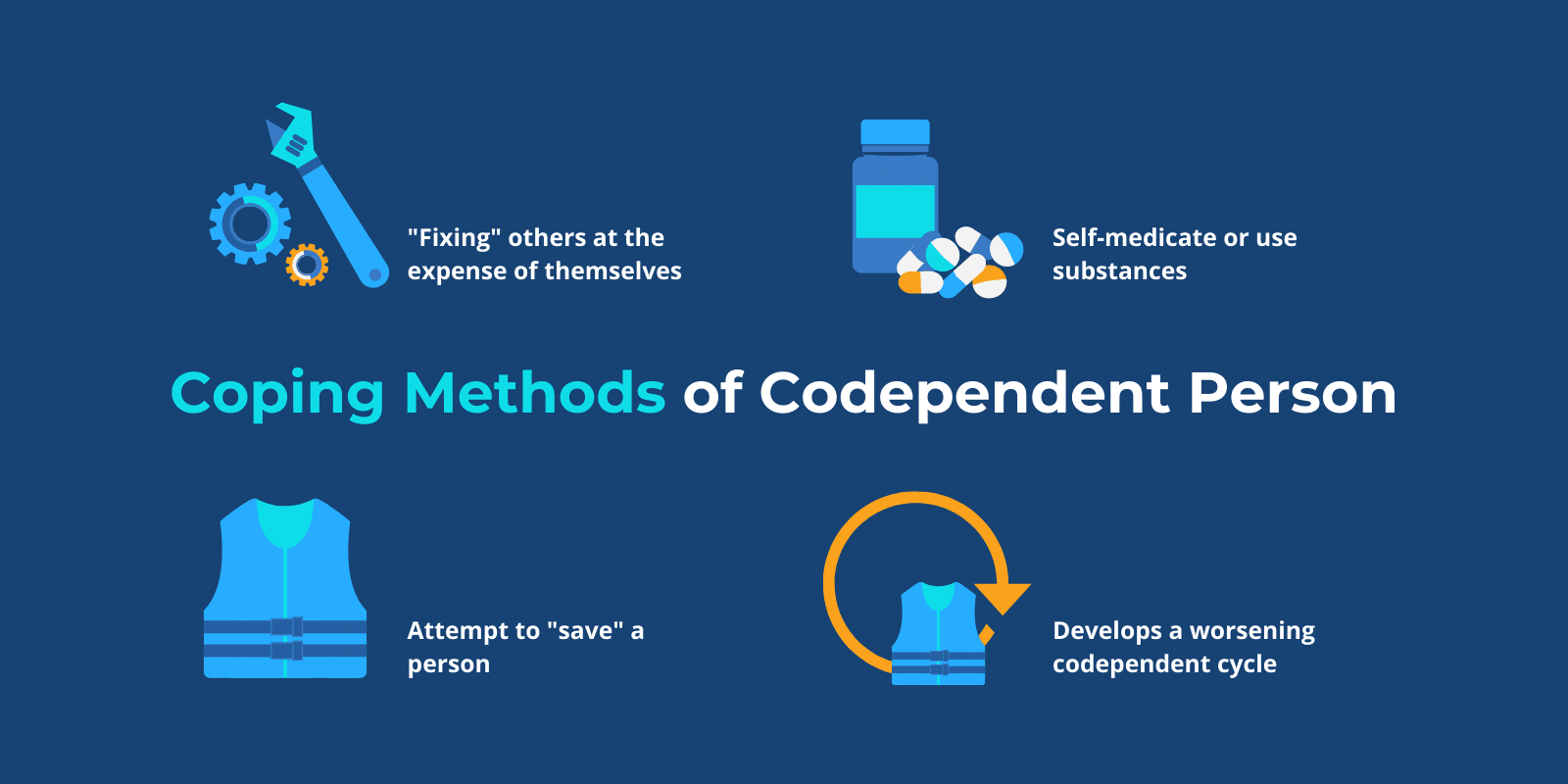
Codependent people usually look for something or someone else to make them feel better.
They may have difficult experiences or feelings that were never identified, so they cope by caring for or “fixing” others at the expense of themselves. Some may try to self-medicate or feel better through substance use and develop an addiction.
A codependent person tries to take care of people who are going through something difficult, even if the help they are giving takes a lot out of them.
Each attempt to take care of or “save” a person contributes to a repetitive and worsening cycle that increases dependency. A person may start to feel rewarded when they are needed.
Codependent people often view themselves as victims and tend to gravitate toward relationships that make them feel better about themselves.
What Are The Characteristics Of Codependency?
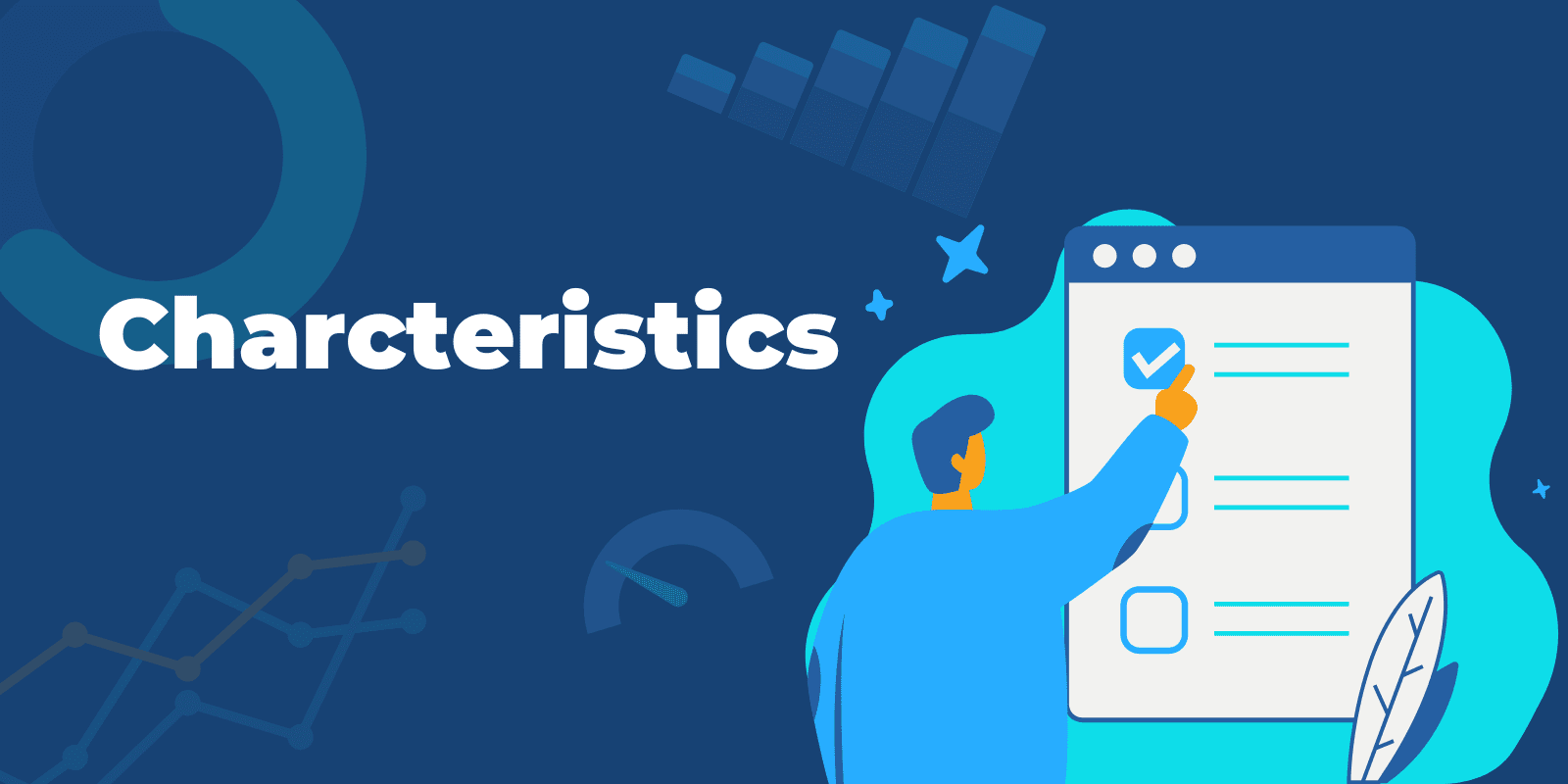
Common characteristics of codependency include:
- Difficulty identifying feelings
- Denying how a person truly feels
- Low self-esteem, never feeling good enough
- Remain in harmful situations
- Sacrificing own needs and interests
- Suppressing feelings
- Want to gain approval
- Avoid change
- Looking to others for a sense of safety and sense of self
- Trouble setting boundaries
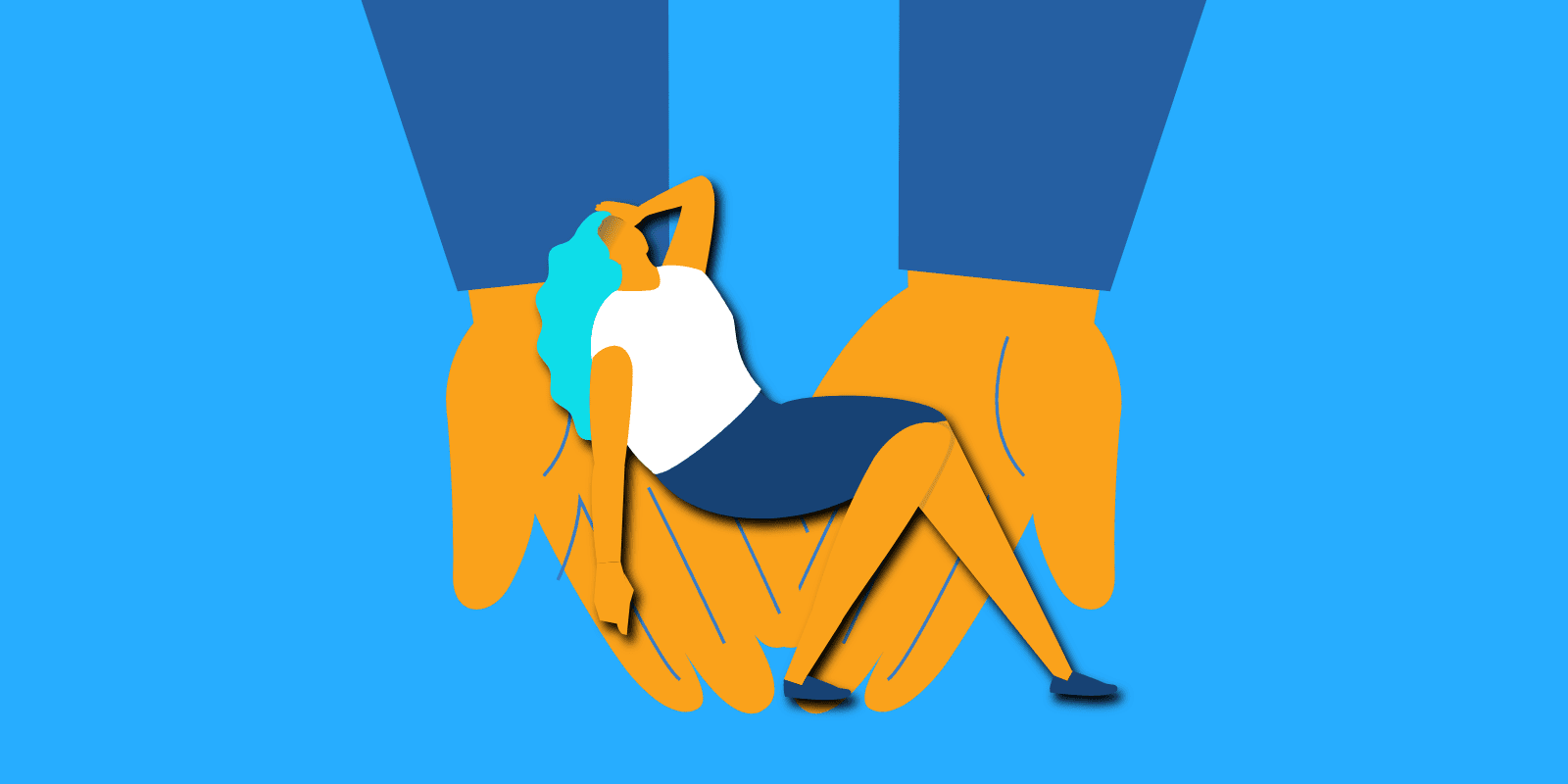
What Are 10 Characteristics Of A Codependent Person?
10 characteristics of a codependent person include:
- An exaggerated sense of responsibility for others
- Confusing love and pity
- Doing anything to hold onto a relationship or avoid abandonment
- Extreme need for approval
- Need to control others
- Lack of trust in others or themselves
- Problems with boundaries
- Difficulty identifying feelings
- Becoming hurt when someone doesn’t recognize their efforts
- Sense of guilt when speaking up
What Is The Main Symptom Of Codependency?
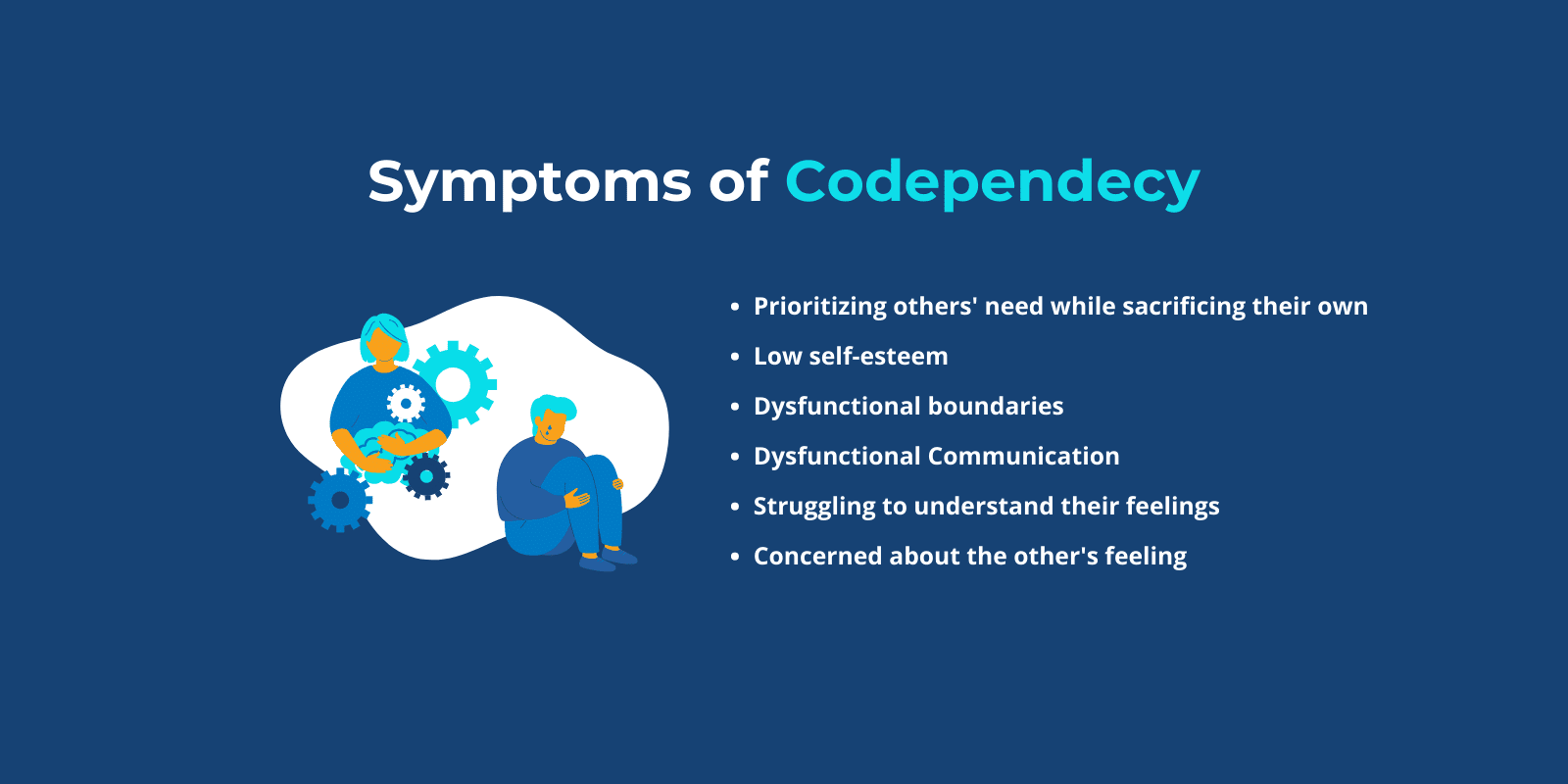
One of the main symptoms of codependency is prioritizing others’ needs while sacrificing your own.
Other common, core symptoms of codependency include low self-esteem and dysfunctional boundaries and communication.
A person who is codependent struggles to get in touch with their feelings because they are more concerned with how the other person is feeling.
How to Stop Being Codependent
How Do You Break Codependency Habits?
To break codependent habits, you have to understand them.
Getting treatment, which usually involves a wide range of different therapies, helps a person to understand their experiences and feelings and how they lead to destructive behaviors.

What Is The Best Treatment For Codependency?
Codependency treatment typically involves experiential groups, individual therapy, family therapy, and group therapy.
Therapy can help a person identify unhealthy thoughts and behavior patterns so they can restructure them.
Codependency often comes from childhood, so treatment usually involves visiting feelings and experiences from the past to understand them better.
What Are The Tools Of Recovery For Codependency?
Tools a person can use to recover and overcome codependency can involve:
- Abstain from obsessive relationships
- Seek help from a Higher power and others in recovery
- Meet with others who share similar experiences
- Call others when help is needed
- Read literature about others’ experiences
- Write or journal to help identify and process feelings
- Acts of service
- Fellowship and community
- Prayer and meditation
Recovering from codependency is centered around accepting yourself, identifying your feelings and needs, and growing your self-esteem.
Recovering from codependency means feeling secure in yourself and your relationships. Maintaining healthy boundaries and problem-solving skills helps a person overcome codependency.
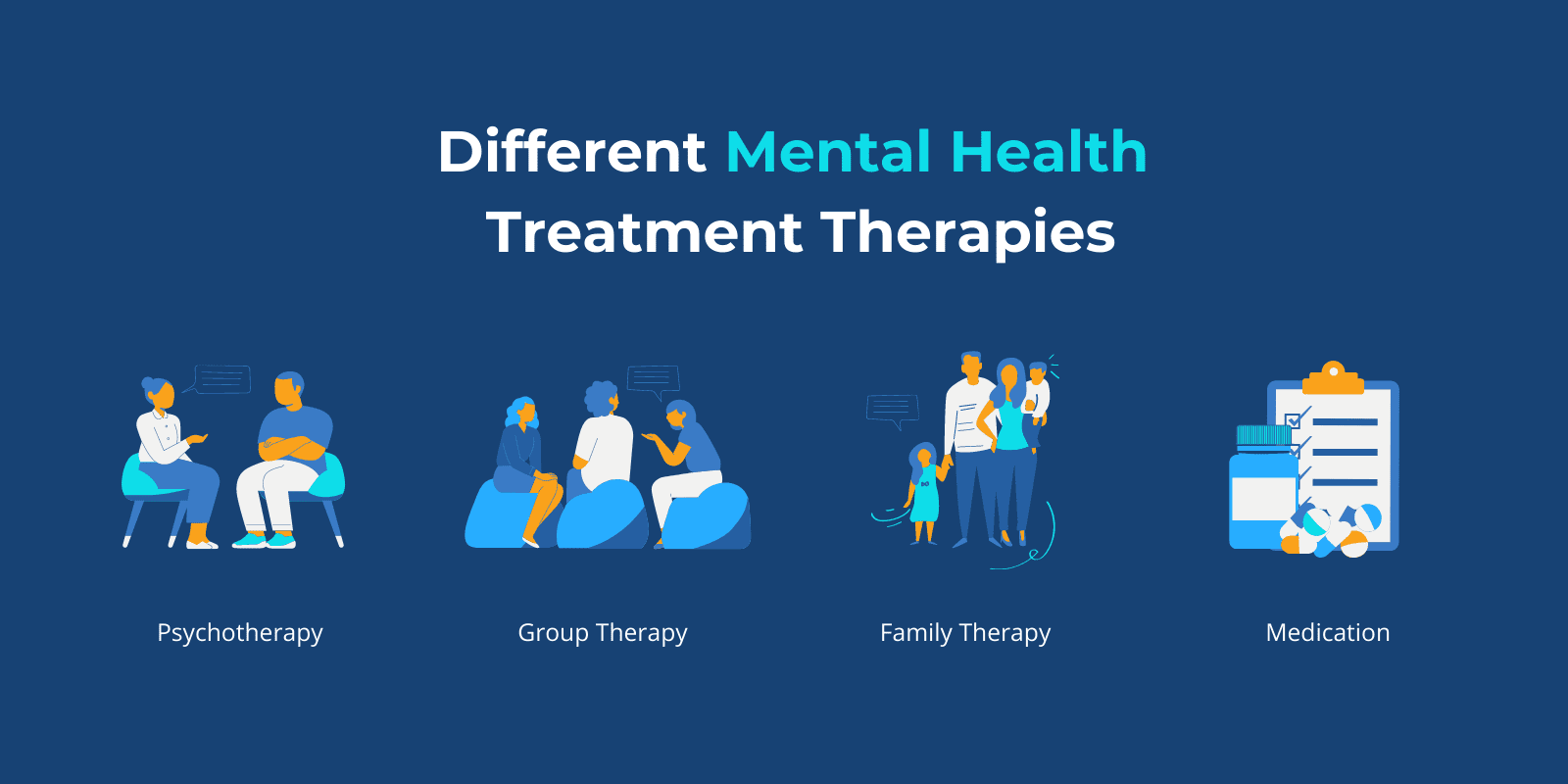
Can You Heal Codependency While In A Relationship?
When a person goes through treatment and therapy for codependency, they may find it beneficial to take a break from their relationship.
Part of healing is learning to put your needs first, practicing self-care, and setting boundaries for yourself.
This can be hard to do while in a relationship and to break the pattern. You want to be able to focus on yourself.
Healing codependency can take a lot of work, and one of the first steps to recovery is being honest with yourself and others. It is important to understand what is best for you and make decisions accordingly.
FAQ
You have questions. We have answers.
Our goal is to provide the most helpful information. Please reach out to us if you have any additional questions. We are here to help in any way we can.
Codependency is an unhealthy relationship where each part is unequal. One person is giving, and the other is taking.
Interdependence is more centered on equality, allowing each part to be autonomous but close.
In an interdependent relationship, there is mutual support and trust. Each person is able to make their own decisions and takes care of themselves while still offering care and love to the other person.
Someone in a codependent relationship relies on the other, sacrificing their needs and suppressing their emotions.
In an interdependent relationship, both parts care for each other without sacrificing themselves and their health for the other, and both are able to fulfill each other because they fulfill themselves.
When looking at codependency and interdependency, codependency is damaging and harmful to both sides, whereas interdependency allows each individual to thrive and have a healthy partnership.
According to the attachment theory, there are four main attachment styles:
- Secure
- Avoidant
- Anxious
- Disorganized
Codependency is often referred to as an anxious attachment style but can also involve behavior for avoidant attachment style.
Someone with an anxious attachment style wants to be close to a person but fears that that feeling is not reciprocated. They may feel that they are never enough and have difficulty with boundaries.
A person with anxious attachment often has a negative self-image but a positive image when it comes to other people. They generally want to feel accepted by others and may blame themselves when a loved one doesn’t satisfy their needs.
A person with an avoidant attachment style may avoid emotional closeness, suppress their emotions, fear rejection, and feel as though their partners are clingy.
Usually, a person that is “taking” rather than “giving” in a codependent relationship has an avoidant attachment style, while the person “giving” has an anxious attachment style.
Codependents and narcissists may share some similarities. However, most people who are codependent are not narcissists.
A narcissist is characterized by a desire to be the center of attention, feeling as if one has a higher status and should be treated as such, and a desire to be admired.
A person who is a narcissist may also be codependent, but they are not the same thing.
One similar characteristic between codependency and narcissism is an unhealthy sense of self and an unhealthy reliance on other people.
A narcissistic personality disorder is also recognized in the DSM-5. Some of the main criteria a person has to meet for narcissist personality disorder include:
- Grandiose sense of self-importance
- Need for extreme admiration
- Lack of empathy
- Sense of entitlement
- Fantasies of success, power, or ideal love
Codependents may obsess for a number of different reasons.
One of the main reasons codependents obsess is because they have a hard time identifying and processing their emotions, so they obsess as a way to tolerate them.
Another reason a codependent obsesses may be because they fear abandonment.
Lastly, it could be because their self-worth is centered around being needed and caring for another person. So, they obsess over being able to do so and will go to great lengths to ensure the other person’s needs are met.
Codependency can be very lonely, whether a person is in a relationship or not.
Whether alone or in a relationship, a codependent person often feels isolated, sad, or unhappy. A codependent person is not incapable of being alone but will often go to great extents to not be alone, even if it is damaging.
Someone who is codependent may have a fear of being rejected or abandoned, so they may fear being alone. This fear of being alone may push a codependent person to stay in an unhealthy relationship and allow the cycle to worsen.
Codependent people often experience negative feelings about themselves.
They may struggle with low self-esteem, insecurity, and lack of a sense of self or their own identity.
Codependent people tend to feel insecure not only about themselves but about their relationships. Codependent people may try to seek validation and self-worth through other people as a way to make up for insecurities.
Recovering from codependency involves building up an individual’s self-worth, learning to set boundaries, and understanding their negative thoughts and feelings so they can learn healthy habits and coping mechanisms.


Let’s take the next steps together
Codependency is a learned behavior that involves an extreme dependence where a person prioritizes anothers’ needs, sacrificing their own well-being. Sandstone Care is here to support teens and young adults with mental health and substance use disorders.



